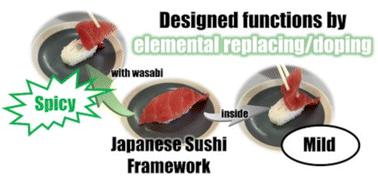当前位置:
X-MOL 学术
›
Chem. Soc. Rev.
›
论文详情
Our official English website, www.x-mol.net, welcomes your
feedback! (Note: you will need to create a separate account there.)
Designed functions of oxide/hydroxide nanosheets via elemental replacement/doping
Chemical Society Reviews ( IF 40.4 ) Pub Date : 2024-10-07 , DOI: 10.1039/d4cs00339j Kanji Saito, Masashi Morita, Tomohiko Okada, Rattanawadee (Ploy) Wijitwongwan, Makoto Ogawa
Chemical Society Reviews ( IF 40.4 ) Pub Date : 2024-10-07 , DOI: 10.1039/d4cs00339j Kanji Saito, Masashi Morita, Tomohiko Okada, Rattanawadee (Ploy) Wijitwongwan, Makoto Ogawa

|
Partial replacement of one structural element in a solid with another of a similar size was conducted to impart functionality to the solids and modify their properties. This phenomenon is found in nature in coloured gemstones and clay minerals and is used in materials chemistry and physics, endowing materials with useful properties that can be controlled by incorporated heteroelements and their amounts. Depending on the area of research (or expected functions), the replacement is referred to as “isomorphous substitution”, “doping”, etc. Herein, elemental replacement in two-dimensional (2D) oxides and hydroxides (nanosheets or layered materials) is summarised with emphasis on the uniqueness of their preparation, characterisation and application compared with those of the corresponding bulk materials. Among the 2D materials (graphene, metallenes, transition metal chalcogenides, metal phosphate/phosphonates, MXenes, etc.), 2D oxides and hydroxides are characterised by their presence in nature, facile synthesis and storage under ambient conditions, and possible structural variation from atomic-level nanosheets to thicker nanosheets composed of multilayered structures. The heteroelements to be doped were selected depending on the target application objectively; however, there are structural and synthetic limitations in the doping of heteroelements. In the case of layered double hydroxides (single layer) and layered alkali silicates (from single layer to multiple layers), including layered clay minerals (2 : 1 layer), the replacement (commonly called isomorphous substitution) is discussed to understand/design characteristics such as catalytic, adsorptive (including ion exchange), and swelling properties. Due to the variation in their main components, the design of layered transition metal oxide/hydroxide materials via isomorphous substitution is more versatile; in this case, tuning their band structure, doping both holes and electrons, and creating impurity levels are examined by the elemental replacement of the main components. As typical examples, material design for the photocatalytic function of an ion-exchangeable layered titanate (lepidocrocite-type titanate) and a perovskite niobate (KCa2Nb3O10) is discussed, where elemental replacement is effective in designing their multiple functions.
中文翻译:

通过元素置换/掺杂设计氧化物/氢氧化物纳米片的功能
将实体中的一个结构单元部分替换为另一个类似大小的结构单元,以赋予实体功能并修改其属性。这种现象在自然界中存在于有色宝石和粘土矿物中,并用于材料化学和物理学,赋予材料有用的特性,这些特性可以通过掺入的异质元素及其数量来控制。根据研究领域(或预期功能),替代被称为“同构取代”、“掺杂”等。在本文中,总结了二维 (2D) 氧化物和氢氧化物(纳米片或层状材料)中的元素替代,强调与相应的块状材料相比,它们的制备、表征和应用的独特性。在 2D 材料(石墨烯、金属烯、过渡金属产铜、金属磷酸盐/膦酸盐、MXene 等)中,2D 氧化物和氢氧化物的特征是它们在自然界中存在、在环境条件下易于合成和储存,以及从原子级纳米片到由多层结构组成的更厚纳米片的可能结构变化。要掺杂的异质元素是根据目标应用客观选择的;然而,异质元素的掺杂存在结构和合成限制。在层状双氢氧化物(单层)和层状碱性硅酸盐(从单层到多层)的情况下,包括层状粘土矿物(2:1 层),讨论了替代(通常称为同晶取代)以了解/设计诸如催化、吸附(包括离子交换)和溶胀性能等特性。 由于它们主要成分的变化,通过同晶取代的层状过渡金属氧化物/氢氧化物材料的设计更加通用;在这种情况下,调整它们的能带结构、掺杂空穴和电子以及产生杂质水平是通过主要成分的元素替换来检查的。作为典型的例子,讨论了离子交换层状钛酸盐 (锂云母型钛酸盐) 和钙钛矿铌酸盐 (KCa2Nb3O10) 的光催化功能的材料设计,其中元素替换在设计它们的多种功能中是有效的。
更新日期:2024-10-07
中文翻译:

通过元素置换/掺杂设计氧化物/氢氧化物纳米片的功能
将实体中的一个结构单元部分替换为另一个类似大小的结构单元,以赋予实体功能并修改其属性。这种现象在自然界中存在于有色宝石和粘土矿物中,并用于材料化学和物理学,赋予材料有用的特性,这些特性可以通过掺入的异质元素及其数量来控制。根据研究领域(或预期功能),替代被称为“同构取代”、“掺杂”等。在本文中,总结了二维 (2D) 氧化物和氢氧化物(纳米片或层状材料)中的元素替代,强调与相应的块状材料相比,它们的制备、表征和应用的独特性。在 2D 材料(石墨烯、金属烯、过渡金属产铜、金属磷酸盐/膦酸盐、MXene 等)中,2D 氧化物和氢氧化物的特征是它们在自然界中存在、在环境条件下易于合成和储存,以及从原子级纳米片到由多层结构组成的更厚纳米片的可能结构变化。要掺杂的异质元素是根据目标应用客观选择的;然而,异质元素的掺杂存在结构和合成限制。在层状双氢氧化物(单层)和层状碱性硅酸盐(从单层到多层)的情况下,包括层状粘土矿物(2:1 层),讨论了替代(通常称为同晶取代)以了解/设计诸如催化、吸附(包括离子交换)和溶胀性能等特性。 由于它们主要成分的变化,通过同晶取代的层状过渡金属氧化物/氢氧化物材料的设计更加通用;在这种情况下,调整它们的能带结构、掺杂空穴和电子以及产生杂质水平是通过主要成分的元素替换来检查的。作为典型的例子,讨论了离子交换层状钛酸盐 (锂云母型钛酸盐) 和钙钛矿铌酸盐 (KCa2Nb3O10) 的光催化功能的材料设计,其中元素替换在设计它们的多种功能中是有效的。


















































 京公网安备 11010802027423号
京公网安备 11010802027423号